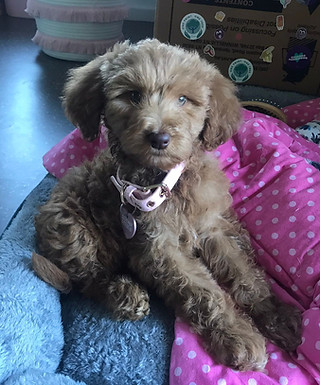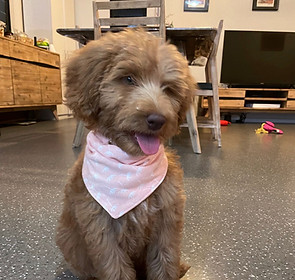
GETTING YOUR HOME READY
To ensure your puppy's safety, it's beneficial to follow these proactive measures (preferably before bringing your puppy home):
-
Safeguard household cleaners and chemicals by keeping them out of your puppy's reach.
-
Restrict access to plants that may pose a danger to your puppy.
-
Store breakable items in secure locations to prevent accidental damage or injury.
-
Conceal or cover electrical cords to deter your puppy from chewing on them.
-
Keep children's toys off the floor, not only for cleanliness but also to prevent the puppy from swallowing small parts.
-
If you have a pool or hot tub, ensure they are fenced off or have a protective cover in place to prevent accidents.

INTRODUCING THEM TO THEIR
NEW HOME
The initial homecoming of your puppy marks a crucial moment for both of you as it signifies the beginning of a lifelong bond. If this is your first time raising a puppy, get ready for an incredibly rewarding experience that may also have its occasional moments of frustration. Upon arriving home with your puppy, it is recommended to take them outside onto the grass to allow them to relieve themselves.
FIRST NIGHT HOME
During the initial nights away from their littermates, it's common for your puppy to experience mild separation anxiety. To help them adjust to their new environment, engage with your puppy as much as possible upon arrival. Establish a designated sleeping area by creating a small enclosed space. Encourage regular intervals of spending time in this area.
When it's time for your puppy to sleep, ensure the enclosure contains soft toys and a comforting blanket. In colder months, a hot water bottle can provide added warmth. It's important not to leave while your puppy is howling or upset. Wait until they have calmed down and become relaxed before departing. Remember that the habits formed in the early stages will likely shape lifelong behaviors.
Transitioning to a new environment can be a stressful experience for a puppy. To minimise their stress, consider the following tips:
-
Maintain Consistency in Diet: Avoid sudden changes to the puppy's diet, as it can cause digestive issues. Stick to the recommended puppy diet to ensure a smooth transition.
-
Prevent Overexertion: Be mindful not to exhaust the puppy with excessive physical activity. Allow for regular periods of rest and provide a quiet space for undisturbed sleep.
-
Establish Safe Confinement: When the puppy is alone, confine it to a secure area to prevent it from wandering off or getting into trouble.
-
Foster Human Interaction: Encourage ample social interaction between your puppy and family members. This helps them feel more comfortable and secure in their new environment.
-
Introduce New People Gradually: Give your puppy time to adjust to its immediate family before introducing it to new individuals. This gradual approach helps reduce stress and allows for smoother socialisation.
-
Enable Exploration: Allow your puppy to explore your home under supervision, helping them become familiar with their surroundings.
-
Provide Fresh Water: Ensure that your puppy has access to fresh water at all times to stay hydrated.
-
Minimise Distractions during Mealtime: Create a quiet and calm environment for your puppy's meals, minimising distractions and allowing them to eat without interruptions.
By following these guidelines, you can help ease your new puppy's transition and create a more comfortable and stress-free environment for them.
ESSENTIAL GUIDELINES FOR BRINGING YOUR NEW PUPPY HOME
PUPPY DIET
Age: 8-12 weeks
-
Provide 3 meals a day along with fresh water for your puppy to drink.
Age: 12-20 weeks
-
Transition to 2 meals a day while ensuring access to fresh water.
WHAT TO FEED
-
Mince: Offer raw beef or chicken mince (avoid cooking it).
-
Occasional Additions: Include cooked rice or pasta with vegetables as occasional additions to their diet.
-
Digestive Balance and Coat Health: Raw eggs and natural yogurt can be beneficial for digestive balance and a shiny coat.
-
Teething Support: Bones are great for teething puppies.
-
Alternative Protein Source: From 12 weeks of age, raw chicken necks can be a suitable alternative to minced beef.
We recommend avoiding processed, canned, and dry foods as much as possible as they may not contribute to optimal health. Providing a nutritious diet during your puppy's early stages will yield benefits during their maturity. Opting for a natural diet that consists of raw, natural foods is considered best.
Please consult with your veterinarian or a professional in animal nutrition for further guidance and to ensure your puppy's specific dietary needs are met.

House Training
House training (toilet training) a puppy or dog requires time, patience, and individualized approach as each pet learns at their own pace, similar to children. To ensure successful and efficient toilet training, it is crucial to use reward-based positive reinforcement techniques. Here are the steps to follow:
-
Provide Ample Outdoor Opportunities: Give your dog plenty of chances to go outside to eliminate. This means taking them to the designated toilet area frequently.
-
Immediate Rewards: Reward your dog every time they successfully toilet in the desired spot. It is essential to offer the reward immediately after the event, within a few seconds. Delayed rewards, such as giving it when the dog returns inside, may not create the association between the right toilet spot and the reward. Rewards can be in the form of praise (e.g., gentle pat or "good dog" in a pleasant tone), food treats, or their favorite chew toy.
-
Supervision is Key: Keep a close eye on your dog throughout the day to ensure you don't miss opportunities to reward their good behavior. The more consistent you are with supervision and rewards, the quicker the dog will learn.
-
Learn the Signs: Observe your dog for signs that indicate they need to go to the toilet, such as sniffing the area, circling, or pausing in a specific spot. Understanding your dog's cues will allow you to anticipate their needs and take them outside promptly.
-
Start the Day Right: Take your puppy or dog to the toilet area first thing in the morning as they often need to eliminate at that time. Repeat this routine frequently throughout the day.
It's important to note that young puppies may not have full control over their urination until they are a bit older. Urination is a developmental process, and accidents can happen as they are still learning to control their bodily functions. Be patient and understanding during this learning phase.
By implementing these techniques and being consistent with training, you can effectively house train your puppy or dog, fostering good habits and promoting a clean living environment.
Regenerate response
.png)

basic training tips
Timing
In dog training, timing plays a crucial role. It is vital to mark your dog's behavior the moment they comply with a command. A simple word like "Yes!" or the use of a clicker can effectively mark the correct behavior. This immediate response lets your dog know that they have successfully followed your command.
body language
Your posture and body language communicate a lot to your dog, just as they learn to read your cues. When giving commands, stand up to establish authority. Avoid keeping your hands in your pockets, as it can become a cue for treats rather than the command itself. Train your dog without holding a treat bag to ensure compliance regardless of treat visibility. Practice training in various locations. Being aware of and mindful of your body language ensures effective communication and enhances the overall training experience for both you and your puppy.
Rewards
Using treats as rewards in dog training is effective, but be careful not to rely on them too much. Gradually decrease treat usage once your dog understands commands. Prompt your dog to sit, wait for compliance, and then reward with a treat. The aim is to teach obedience to verbal commands, ensuring good behavior even without treats. This builds a strong foundation of obedience beyond treat incentives.
consistency
Consistency is vital in puppy training because it helps establish clear expectations and boundaries for your puppy. By maintaining a consistent training approach, you prevent confusion and create a structured environment that promotes learning and development. When everyone in the household follows the same training methods consistently, it becomes easier for the puppy to understand and respond appropriately. Ultimately, consistency sets the foundation for a well-behaved and obedient dog.
life rewards
Food is commonly used as a reward in dog training, but it's not the only option. Toys, games, and even car rides can serve as rewards too. For instance, if you want to teach your dog not to rush out the door, try this approach: Ask your dog to sit-stay by the door. If she obeys, praise her and allow her to go outside as the reward. If she moves, close the door and retry. Repeat until she stays put while the door opens. Only then does she earn the reward of going outside. Apply the same method for car rides, rewarding her with a ride if she remains in position.
keep it fun
Making puppy training fun helps create a positive association with training, making your puppy more eager and motivated to learn. When training sessions are enjoyable, your puppy will be more engaged and focused, leading to better results. Incorporating play and games into training sessions provides mental stimulation for your puppy, which is essential for their overall well-being.
toxic food list
It is important to be aware that certain foods can be toxic to dogs, posing serious health risks and even potential fatality. Here are some examples of these harmful foods:
-
Chocolate
-
Onions and garlic
-
Macadamias and almonds
-
Grapes and raisins
-
Pear and apple pips
-
Plums, apricots and peach seeds
-
Potato peelings and green potatoes
-
Rhubarb leaves
-
Mouldy or spoilt food
-
Mushrooms
-
Alcohol
-
Yeast dough
-
Coffee grounds, beans and tea
-
Tomato leaves and stems
-
Broccoli (large quantities)
-
Compost
-
Animal fat (large quantities)
-
Various common garden plants


pet insurance
Pet insurance is important because it provides financial protection and peace of mind. It helps cover the cost of unexpected veterinary expenses, ensuring that your pet can receive the necessary medical care without you having to worry about the financial burden. With pet insurance, you can make decisions about your pet's health based on their well-being rather than the cost of treatment. It also allows you to proactively manage your pet's health by providing coverage for preventive care and early intervention. Overall, pet insurance ensures that your beloved companion can receive the best possible care, giving you the assurance that you can provide for their needs in times of illness or injury.
